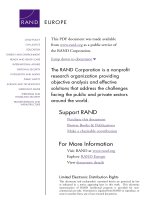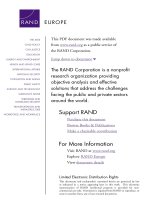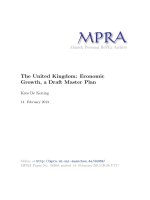LITERATURE REVIEW :The ecosystem approach, ecosystem services and established forestry policy approaches in the United Kingdom
Bạn đang xem bản rút gọn của tài liệu. Xem và tải ngay bản đầy đủ của tài liệu tại đây (92.48 KB, 10 trang )
LITERATURE REVIEW
The ecosystem approach, ecosystem services and established forestry policy
approaches in the United Kingdom
Susanne Raum ., Centre for Environmental Policy, Faculty of Natural Sciences, Imperial
College London, South Kensington Campus, London SW7 1NA, United Kingdom
INTRODUCTION
In recent decades, thousands of research from many authors mentioned about approaching
methods indicated for natural resources management and biodiversity conservation. More
specific in forestry, multi-purpose forestry and sustainable forest management are the dominant
policies not only in United Kingdom, also including global scale. The Convention on Biological
Diversity, ecosystem approach and ecosystem services has become parents method or based
methodology for natural resources management. In order to response to the 1919 Forestry Act
(Mather, 1991), based on towards state organization and productive plantation forestry, specially
in 1990,sustainable forest management applied. The Convention on Biological Diversity's (CBD)
in ecosystem approaching has become to be effective method of policy in natural resources
management and biodiversity conservation with long-term strategies for sustainability develop
cause by management and conservation together. It meant to be the changing in approaching
methods lead to be many positive consequences, such as positive changing in policy and forestry
practice. Forestry in the United Kingdom has had to adapt its policy approach repeatedly to
changing macroeconomic circumstances, fluctuating public opinion, the growing importance
given to non-timber benefits of woodlands, and increasing international influences and
obligations (Raum and Potter, 2015). Beside those positive consequences which mentioned
above, some ecosystem concepts composite to lead to become many debates. However we can
not deny positive aspects of them and vice versa it could be “another extension or re-packing of
existing approaches”. Although there are number of reports from international about interrelationship between sustainable forest development and ecosystem approach but it has lack of
information about ecosystem approach in United Kingdom. So in order to resolve that issue from
lack of real information and misunderstanding about approaching methods. So with 2 trending of
methods that ecosystem approach and sustainable forest development, we will be discussed
about establishing the forestry policy. This paper which is based on a review of the literature and
documents and a survey of expert views aims to do just that with the intention to advance
understanding of these approaches amongst the academic, policy-making and forestry
communities. I proceed with a general overview and a summary of the employed approach and
methods. For the purpose of this analysis, I applied a qualitative and interpretive approach,
centered on textual information. In an attempt to archive a higher level of understanding of the
differences and similarities of the forestry and conservation policy approaches discussed here, I
triangulated academic literature and legislative and policy documents with expert interviews.
Textual data was derived from scholarly work and non-research based material in the form of
relevant policy and legislative documents..
SUMMARY OUTLINE OF THE POLICY APPROACH USED IN THIS
ANALYSIS AND THEIR LEGAL BASIS
In this part, the author indicated the policy and legal basis of some key policies approach
discussed. The two well-established forestry policy approaches of multi-purpose and sustainable
forestry and the two popular conservation approaches, the ecosystem approach and the
ecosystem services concept. The author begin each sub-section with a more widely used
definition, followed by a summary of some of the most relevant key international, EU and
United Kingdom legislation, including ‘soft law’. Then, the author list some of the most
significant policy statements.
Multi-purpose forestry
With the definition about multi-purpose in forestry become more popular that: “no formal and
generally accepted definition for multi-purpose forestry either in the United Kingdom or
elsewhere could be found”.
The Countryside Act and The 1985 Wildlife and Countryside (Amendment) Act established the
first legal required to broader forestry objectives: “for the conservation and enhancement of
natural beauty and for the benefit of those resorting to the countryside” (HMSO, 1968). This act
supported to sustainable management when they focused on local and conservation in their
objectives further more in sporting instrument, tourisms,etc. , and for soil and water conservation
measures (EEC, 1989), and the 2009 EU Renewable Energy Directive (e.g. European Commission,
2009) which included woody biomass.
Some policy statements that appeared to be no specific forestry policy document on multipurpose or multi-functional forestry other than the 1985 Broadleaved Policy (Forestry
Commission, 1985) which aimed at halting further convergence of broadleaved woodlands to
conifer plantations.
Sustainable forest management
Sustainable forest management defined : “the stewardship and use of forests and forest lands in
a way, and at a rate, that maintains their biodiversity, productivity, regeneration capacity, vitality
and their potential to fulfil, now and in the future relevant ecological, economic and social
functions, at local, national, and global levels, and that does not cause damage to other
ecosystems” (MCPFE, 1993). Planning and Compulsory Purchase Act (HMSO, 2004). Some of
these include mechanisms and qualifications for encouraged between the economic, social and
environmental objectives, albeit frequently”. But not necessary to take this act cause by not
effective to environmental issues. In that case, the 1992 UN Forest Principles, a ‘non-legally
binding authoritative statement of principles for a global consensus on the management,
conservation and sustainable development of all types of forests’, introduced ‘Sustainable Forest
Management’ through a set of 15 voluntary principles (UNCED, 1992)
The ecosystem approach
The ecosystem approach as “a strategy for the integrated management of land, water and living
resources that promotes conservation and sustainable use in an equitable way” (CBD, 1995)
In 1992, the CBD adopted the ecosystem approach and subsequently developed a more detailed
set of 12 ecosystem approach principles which were supported by five operational guidelines
(SCBD, 2000). The principles and guidelines were formally adopted in 2000 (SCBD, 2000)
The 2006 Natural Environment and Rural Communities Act (HMSO, 2006) which extended this
obligation to all public bodies, including the Forestry Commission
The use of the ecosystem approach principles has also been advocated in general terms, for
instance, in the 2016 Land Use Strategy for Scotland (The Scottish Government, 2016).
There are a number of more general policy statements on the ecosystem approach, beginning
with the government's 2007 Ecosystem Approach Action Plan (Defra, 2007b). This was taken up
by the Forestry Commission in its revised 2011 UK Forestry Standard format which made, for
the first time, a more detailed reference to the CBD's ecosystem approach.
The ecosystem services concept:
The MA (2005), which mainstreamed the concept of ecosystem services, provided the currently
most frequently used definition and typology for ecosystem goods and services. It defined them
plainly as “benefits people obtain from ecosystems”, and divided goods and services into the
widely used four categories of provisioning, regulating, cultural, and supporting services which
include 24 goods and services (MA, 2003)
In the context of forests, the 2007 Non-Legally Binding Instrument on all Types of Forests
(NLBI), especially, “encourages recognition of the range of values derived from goods and
services provided by all types of forests and trees outside forests, as well as ways to reflect such
values in the marketplace, consistent with relevant national legislation and policies” (UN, 2007)
The 2015 MCPFE Madrid Ministerial Resolution 1 (MCPFE, 2015) also commits itself to
“incorporating the value of forests ecosystem services in a green economy”, including through
tools such as “market-based instruments and payments for ecosystem services”.
These transnational ideas were taken up by the United Kingdom government in numerous more
general policy statements, beginning with the 2007 Ecosystem Valuation Guide (Defra, 2007a).
The Forestry Commission made an explicit reference to ecosystem services in its 2011 UK
Forestry Standard (Forestry Commission, 2011). There, it also provided an extensive list of
woodland ecosystem services, building on the 2005 MA and the 2011 UK National Ecosystem
Assessment (UK NEA, 2011).
THE UNDERSTANDING AND INTERPRETATIONS OF FORESTRY STAKEHOLDERS
In this part, I examine how the ecosystem approach and the concept of ecosystem services are
understood and interpreted in the UK, and in the light of existing forestry models. In the UK
forestry sector, as elsewhere, there appears to have been a tendency to conflate policy concepts.
An analysis of the literature and the interviews indicated this to be the case, especially in the
1990s between the established idea of multi-functional forestry and the new concept of
sustainable forest management (e.g. Mather, 2001), and today, in relation to the ecosystem
approach and the ecosystem services concept (e.g. Waylen et al., 2014), and between these two
concepts and established forestry approaches. Quine et al. (2013), for instance, observed that
many forestry discussants appear to miss the differences between the various concepts, and so
tend to use their specific terminology “seamlessly and interchangeably”, arguably layering new
ideas on top of existing ones, frequently without understanding the full details (p. 863). The
outline of the policy and statutory documents in the previous section also hinted at how
interlinked and ambiguous these markedly different, but overlapping policy approaches are. The
interviews confirmed these findings. However, the interviews also suggested that this complexity
and accumulation of thinking may be navigated differently by people in different communities
with different understandings and interests. Others, consciously re-brand existing ideas because it
better suits their goals and interests. Moreover, the interviews indicated that there may be
considerable policy fatigue amongst some stakeholders. These themes will be examined below
through a comparison of the similarities and differences of the four key policy approaches.
Multi-functional forestry versus sustainable forest management
The first challenge considered here appears to have occurred in the 1990s when the sustainable
forest management model was introduced to UK forestry. Multi-functional forestry had been the
guiding principle for forestry policy, particularly in the 1980s. The approach encouraged the
delivery of more than one forest management objective, placing particular emphasis on the nonmarketed forest benefits of landscape amenity, recreation, and nature conservation which
increasingly had to be balanced with the traditional demands of commercial timber production.
The widening of forestry objectives was seen as a necessary means to increase public
acceptability of state-funded reforestation programmes. One state forester described the situation
at the time:
“Foresters in Britain needed to take this approach for the reforestation programme to have
credibility and public acceptability. … In the 1970s, there was a fairly critical report 1from the
government on the cost- benefit analysis and so immediately the forestry industry was more or
less saying, how do we justify the fact that we are not making a suitable return from our timber?
Ah, its’ been all these other things we are delivering, recreation, landscape, biodiversity, nature
conservation”.
Still, under the multi-functional forestry approach, non-timber management objectives remained
secondary to timber production (NAO, 1986). Hence, the search for a more balanced approach to
forest management continued, leading to the development of the concept of sustainable forest
management which aimed at balancing economic, social and environmental aspects of forestry.
However, when the concept of sustainable forestry was introduced to the UK, forestry
stakeholders seemed to have struggled to understand its full meaning. Indeed, one interviewee
from the private forestry sector noted that
“… when sustainability came in, nobody knew what that was …”
At the time, the sustainable forestry management concept appeared to have been layered on top
of the existing multi-functional forestry model. Certainly, in the early noughties,
Alexander Mather (2001) observed that sustainable forest management had become almost
synonymous to multi-functional or multi-purpose forestry. In later years, however, these two
concepts tended to be used in paralleled, rather than being seen as identical (Cubbage et al.,
2007 ; Slee, 2012). Today, multi-functional and sustainable forestry seem to underpin forestry
policy conjointly. During interviews, one respondent from one of the conservation organisations,
for instance, stated that
“Forestry policy, as far as we are concerned and the government is still concerned, is
about sustainable multiple benefits forestry. …”
However, in forestry, the idea of sustainability was not new to Europe, as a similar approach had
been practised in several European states since the nineteenth century. In fact, the concept of
“sustained yield of timber” had received considerable attention in central Europe. Its core idea
stipulates that the annual timber harvest should equal the annual growth rate, leading to a
continuation of forest growth (Wiersum, 1995). />Multi-functional forestry versus the ecosystem services concept
. Amacher et al. (2014), for instance, claim that currently, the traditional idea of multi-functional
forestry and its associated notion of non-marketed forest benefits is regularly replaced with
today's ecosystem services terminology. This view was confirmed during the interviews, where
several respondents maintained that ecosystem services constitute a re-emergence of multifunctional forestry. Indeed, it was suggested that foresters frequently assume that ecosystem
services are the same as non-marketed forestry benefits. One interviewed expert from the private
forestry sector, for example, noted that ecosystem services are:
“Just a re-iteration, a re-emergence of multi-functional forestry. …. It is just a new name for
multi-purpose forestry, that's all it is”.
Similarly, a government forester observed that:
“In a way, the whole ecosystem services idea is something that, under different governments,
foresters have been forced to work on since at least the 1960s. It had had different names e.g.
multiple benefits and non-marketed benefits. … So, that sort of idea is more or less ingrained in
forester's language and approaches. … So, I think, for the forestry sector, the ecosystem services
approach was a lot easier to take on than for some other sectors: Foresters could say ‘oh,
ecosystem services, hang on, that's just these non-marketed benefits by a different name and
somewhat expanded”. .
Unsurprisingly, this layering of concepts and their associated terminology, this accumulation of
thinking, that is, when new ideas appear on top of existing ones, but old ones are not necessarily
discarded, seems to be navigated better by some people than others. Indeed, the analysis of
interview transcripts suggested that those forestry related stakeholders who were, as part of their
work, regularly exposed to the national level and international environmental policy dialogues
and documents, tended to understand the differences better than those operating more on a
regional and local practitioner level. One of the interviewed state foresters explained this
distinction, using the example of ecosystem services:
“The language for the practitioners is not that accessible, and so, I think people would not
necessarily be able to describe ‘provisioning’, ‘regulating’, ‘cultural’, and ‘supporting’. I mean,
they may not even find all of those words. I think cultural is one that is fairly commonly
understood compared to perhaps provisioning, whether people would then allocate individual
services into the right categories is still debatable. So, that is at the kind of practitioner level, I
think at the policy level, there is a clearer understanding”.
It also arose during interviews that there was a particularly strong interest in the rebranding of
non-marketed benefits into ecosystem services as it holds a greater promise for new sources of
funding. One respondent from the conservation sector, for instance, stated that:
“The idea of ecosystem services is appealing because it sort of holds out the possibility of
generating a market and therefore allowing consumers of the benefit to pay to the providers of
it”. />Sustainable forest management versus the ecosystem approach
Similarly, particularly in those countries where sustainable forest management has been
attempted or applied, there has tended to be a certain confusion around the concept of sustainable
forest management and the ecosystem approach. Indeed, this problem had been addressed
repeatedly since the formal adoption of the ecosystem approach by the CBD in 2000 by various
organisations (e.g. FAO, 2003 ; UNEP, 2003a). In 2003, the CBD for instance, in a document
titled ‘Further Elaborations and Guidelines for the Implementation of the Ecosystem Approach’,
accepted sustainable forest management “as a means of applying the ecosystem approach to
forests” (UNEP, 2003b, p. 34). This view had been confirmed at the Seventh Ordinary Meeting
of the Conference of the Parties to the Convention on Biological Diversity (CBD, 2004) and was
reiterated during the expert interviews in this study. Moreover, one state forester pointed out that
“… latterly there has been an accord, certainly at a European level, that confirms that
sustainable forest management is sort of consistent with an ecosystem approach, as it is
understood by the CBD”. />The revised 2011 UK Forestry Standard also established that the CBD's 12 ecosystem approach
principles “are being applied through the UN principles of sustainable forest management
already agreed” (Forestry Commission, 2011, p.8). The same government forester as above
explained, in more detail, how in the UK the ecosystem approach principles are already
embedded in the existing sustainable forest management framework:
“A lot of the principles of the broader ecosystem approach paradigm are already embedded in
two existing forestry mechanisms: a) the UK Forestry Standard … which articulates the standard
to which things should be done to be assured that they are sustainable; and b) the voluntary
certification schemes that have a similar statement of principles but are administered by private
bodies or charitable bodies, and result in the equivalent of FSC certification…. So, I think that is
where, in a way, a lot of the dialogue in forestry might be found, in those sorts of mechanisms”.
/>However, he further pointed out that:
“…the ecosystem approach as a kind of phrase is not one that we make a lot of use of in forestry,
and yet a lot of what we are doing is consistent with an ecosystem approach…. So, I think,
certainly, in British forestry, the language is being more around sustainable forest
management”.
Clearly, both the literature and several interviewees considered the established sustainable
forestry framework, which has been the essential guiding principle since the early 1990s in UK
forestry, as fulfilling the international obligations of the CBD regarding its ecosystem approach
commitments. />Sustainable forest management versus the ecosystem services concept
In line with current international trends, Defra, as the lead public agency responsible for forestry
in the UK, and the Forestry Commission England and its regional equivalents have, in recent
years, explored how best to apply ecosystem services thinking to forestry policy and practice.
This included various statements of intent and a number of forestry workshops and conferences
convened by the Commission and several other organisations (Mason and Mencuccini, 2014).
However, since sustainable forest management is continuing to frame forestry policy and
practice, there is the potential for yet another conflation of concepts. One conservation expert
elaborated on these technicalities:
“… within forestry, I would say that sustainable forestry hasn’t gone away, it's just that
ecosystem services is a new badge on top of it. It is not like one concept has been stopped, and
we say, “Right, we are going to stop doing sustainable forestry today, tomorrow we do ecosystem
services”. No, that hasn’t been the case. …. So, ecosystem services are something else that is
coming in and it is picking up on some of the things we are already doing … but the sort of
previous arguments about how you do forestry, they haven’t gone away”.
“So that [the UK Forestry Standard] hasn’t gone away, other things have come in on top of that.
So, ecosystem services come into that environment, some of these services are thought about
within forestry, they are part of sustainable forest management. It is just then a question of how
you package it, there may be new services come in, etc. …”
/>Crucially, this practice of packaging or rebranding policies was brought up repeatedly during the
interviews. It also appears to contribute to policy conflation and even policy fatigue. A forester
from the conservation sector, for example, stated:
“… The previous forestry argument [SFM] which still runs on, it has been a very important
component in forestry policy and regulation development…. So, ecosystem services are just
another thing that has come in, which in forestry you could argue, it is almost rebranding things
that are already happening”. />Similarly, another interviewed academic added:
“Currently, in some places people have rather simplistically bolted it on or altered their
language to, kind of, try to accommodate an ecosystem services framework …”
Yet, another from the conservation sector noted:
“It is the next bandwagon. A few years ago people talked all about climate change, now they are
talking about ecosystem services …. You have new administrations come in, and … the policies
get repackaged to suit the new administration, it's kind of normal really …. So, if you go back,
pre-2012, before May 2010 in England with the general election, the labour administration was
very interested in climate change. So, anything in forestry was batched up as climate change ….
Now, less so, now ecosystem services, as well as economic stuff are the flavour of the month.
Climate change is still part of that, but people repackage it, you know people in the forest
industry want to plant trees, so they find a new argument to do that”.
“There are other things as well, talk about the ecosystem approach … sustainable forestry …
managing for biodiversity, but also … landscape. So, a lot of this isn’t new, the relative emphasis
might be in the packaging, in the policy push which might be slightly different, but it is not new”.
/>Moreover, and perhaps unsurprisingly, a number of interviewees expressed their unease with
such regular change or re-packaging of policies, depended on “the political flavour of the day”,
as one respondent put it. Indeed, several respondents indicated that there is currently a
considerable level of policy fatigue, especially amongst practitioners. One interviewee, for
example, commented, somewhat cynically:
“… [ecosystem services] is the government in-word for now, it will change, there will be other
ones”.
Regardless, and as already pointed out before the established sustainable forest management
concept continuous to frame forestry policy and practice in the UK. This, however, needs to be
understood more generally. The forester from one of the conservation organisations stressed this
point:
“Well …, within [UK] forestry … there has been a concept of sustainable forest management and
practical guidance and regulation, trying to work towards that within forestry for a long time. It
isn’t perfect, it isn’t working brilliantly, and some of that includes ecosystem services already. So,
it is not kind of a new thing …. So, it is more a question of the ‘ecosystem services people’
needing to understand the sectors they are trying to influence and understand where they are
coming from and what needs to be done”.
This comment suggests that there may be a need to gain more widespread recognition that
sustainable forest management displays many elements of the ecosystem approach in the UK
forestry sector and should be promoted as such. Moreover, the above indicates that it may be
necessary for the responsible government organisation, such as in forestry and planning, where
ecosystem-like approaches have already been integrated.
CONCLUSION
In this literature review, I would like to focus on inter-relationship into key forestry and conservation
policy approaches. In UK forestry, the ecosystem approach and the ecosystem services concept are
nothing fundamentally new as novelty in equivalent to sustainable forest management, and the latter is
understood as an extension of sustainable forest development and multi-function forestry in natural
resources management . However, by also touching upon the potentially transformative nature of its
general application on forestry, this article seeks to corroborate an emerging view of the established
concept of sustainable forest management potentially becoming conflated with the notion of ecosystem
services. Therefore, an urgent need to address the current conflation of policy approaches and concepts
and to gain more widespread acceptance that sustainable forest management continues to frame
understandings amongst a wide range of stakeholders. Indeed, it was seen as fulfilling the UN
Convention's ecosystem approach requirements, as it displays many elements of sustainable forest
management, and should be promoted as such. Moreover, this literature review concluded that for clear
concepts and definitions and equally unambiguous principles for any policy approach in order to ensure
that their implementation yield the intended effects. The risk of stakeholders involved in their
implementation may become disillusioned and policy fatigued must be avoided so that they can undertake
their vital tasks unimpeded.
REFERENCES
/>
/> /> /> /> /> />









